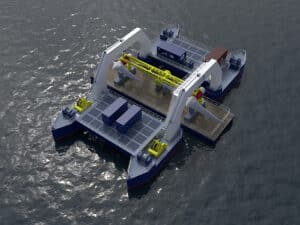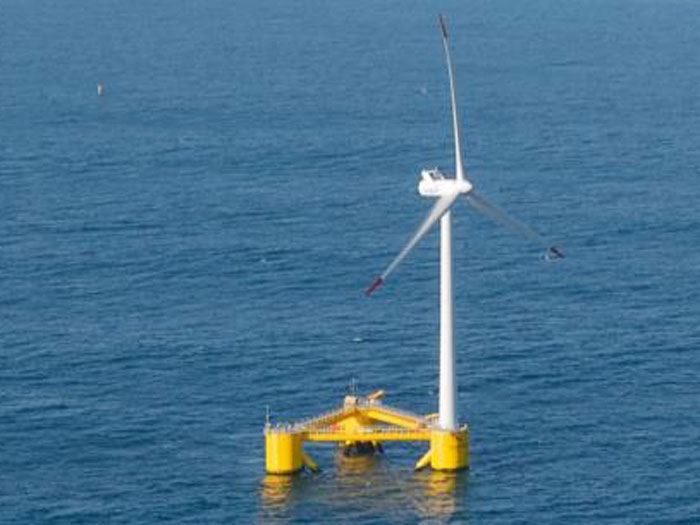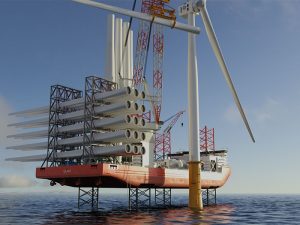
Oregon offshore wind project advances
Written by Nick Blenkey
FEBRUARY 6, 2013 — The Bureau of Ocean Energy Management (BOEM) has given the green light for Principle Power, Inc., Seattle, WA, to submit a formal plan to build a 30- megawatt pilot project using floating wind turbine technology offshore Coos Bay, OR.
The WindFloat technology being used by Principle Power is a breakthrough in offshore wind technology in at least two ways. It allows turbines to be installed in depths to deep for fixed wind turbine installations — and it does not require the use of a specialized wind turbine installation vessel.
Principle Power will seek to site its project within a 15 square mile proposed lease area. The project is designed to generate electricity from five floating WindFloat units, each equipped with a 6-megawatt offshore wind turbine. The turbines would be connected by electrical cables and have a single power cable transmitting the electricity to the mainland. The facility, sited in about 1,400 feet of water, would be the first offshore wind project proposed in federal waters off the West Coast and the first in the U.S. to use a floating structure to support offshore wind generation in the Outer Continental Shelf.
Principle Power, Inc., which received $4 million in Department of Energy funding for its advanced technology demonstration project, submitted an unsolicited request to BOEM for a commercial wind energy lease in May, 2013. As an initial step in the leasing process, in September, BOEM issued a Request for Interest (RFI) in the Federal Register to determine whether there were other developers interested in constructing wind facilities in the same area proposed by Principle Power, Inc. The RFI was also the first opportunity for public comment on site conditions and multiple uses within the proposed lease area. The public comment period closed on October 30, 2013.
BOEM received 18 responses to the RFI, none of which expressed a competitive interest in the area proposed by Principle Power, Inc. Accordingly, BOEM published a Determination of No Competitive Interest in the Federal Register. The majority of the comments submitted to BOEM discussed potential effects on commercial fisheries, which BOEM will consider during the course of evaluating the project.
Under the noncompetitive process for which Principle Power qualified, the company may now submit a plan for the proposed lease area to BOEM. BOEM will then complete a National Environmental Policy Act analysis, which includes opportunity for public comment, before making any final decision on lease issuance and plan approval.
Principle Power says that the WindFloat is a patented floating foundation for offshore wind turbines. The WindFloat’s innovative features allow wind turbines to be sited out-of-sight from shore in deepwater locations where the wind is stronger and more consistent. The WindFloat eliminates the need for seabed-disturbing foundation structures and can be sited to avoid conflicts with other marine uses. To date, offshore wind farm locations have been limited by technology and project economics to environmentally and stakeholder sensitive shallow water areas near-to-shore. The WindFloat offers considerable economic advantages over traditional offshore wind foundations because the entire turbine and floating foundation is built on shore, and installed with conventional tug vessels. The WindFloat is a cost-effective, simpler and less risky approach for offshore wind development.
A prototype WindFloat system (WF1), equipped with a Vestas v80 2.0 MW turbine, has been operational off the coast of Portugal since October 2011 and has delivered in excess of 7GWh of wind energy to the local grid. WF1 was the first multi-megawatt offshore wind turbine in the world to be installed without the use of heavy lift vessels or offshore construction equipment. Additionally, no pilings or seabed foundations were required, eliminating offshore construction related noise. All final assembly, installation and pre-commissioning of the WindFloat (including hull and turbine) took place on land in a shipyard’s dry-dock. The complete system was then towed offshore using conventional tug vessels.
“WindFloat Pacific is the first offshore wind project proposed for the West Coast of the United States, an area which has the potential to contribute vast amounts of offshore wind renewable energy,” says Alla Weinstein, President and CEO of Principle Power. “With the water depth off the West Coast prohibiting installation of fixed foundations, floating offshore wind solutions are a necessity. WindFloat is an enabling technology positioned to open the US West Coast to offshore wind development, while creating a new industry and local jobs.”





Leave a Reply
You must be logged in to post a comment.